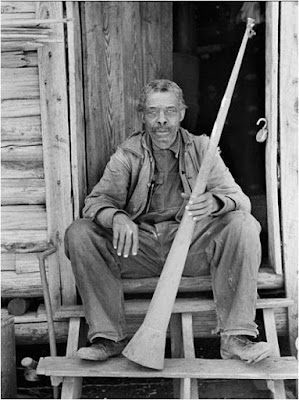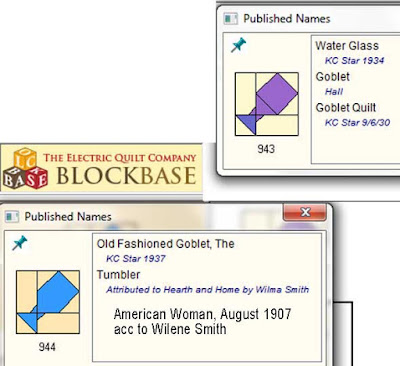Emiline F. Cross attended Mount Holyoke Seminary in South Hadley, Massachusetts, thirty miles from her home, graduating from the elite women's academy in 1854 when she was about twenty. She must have been well-liked as classmates made her a gift of an album quilt.
Emiline's quilt from Massachusetts Quilts: Our Common Wealth.
Collection of the Blandford, Massachusetts Historical Society
The pattern was also popular. We'd call it Lady of the Lake or Lost Ship. The name Lend & Borrow refers to the way the red and white shapes shift from positive to negative spaces when it's set like this. Just like last month's block, it's not what we'd think of when we decide to piece a friendship quilt. But Emiline's generation, the first to adapt albums to patchwork, thought the block with two different triangles quite the thing for single pattern or sampler quilts.
Quilt with blocks dated 1839-1843 from the Silber Family collection,
possibly New Jersey. Blocks in this quilt dated 1839 are among
the earliest surviving examples of friendship style blocks.
Mount Holyoke about 1870.
Over 300 pupils and teachers lived in the five-story building.
Mary Lyon, 1797-1849
Like founder Mary Lyon, Mt. Holyoke Seminary became a pillar of New England's cultural temple so Southern girls were unlikely to enroll.
Classroom and students about 1870
In a list of 307 students and teachers in Emiline's class of 1853-1854 the majority were from New England states with westerners from Pennsylvania and Indiana to Wisconsin. I counted only one woman who might be considered a Southerner in the class of 1853-54. (Two others were from St. Louis and Washington City, cities with Southern roots that remained in the Union.)
Sarah Jane Foster traveled from Jonesborough, Tennessee
to South Hadley, Massachusetts for school. Most of
her fellow pupils were from the green Union states here.
Sarah Jane's interest in Mt. Holyoke might have been due to dreams of becoming a missionary. Alumni records indicate she married a widowed missionary in 1860, taught in Oroomiah, Persia and returned to Tennessee in 1869 after his death.
Same classroom, same day
Why did New Jersey's St. Mary's Seminary attract Virginians like Indiana Fletcher while Mt. Holyoke enrolled more girls from the South Pacific than the southern states? It was probably both curriculum and culture. Mt. Holyoke's classes were more academic than schools aiming to turn out cultured wives: Latin and logic, history, philosophy, algebra, music, science and calisthenics followed by examinations described as "severe" by Emily Dickinson. A Mount Holyoke graduate might become a teacher, spreading Miss Lyons's ideals to the next generation.
The Library
Mt. Holyoke's values were embedded in New England's culture of independence, self reliance, reform and improvement. Rather than being waited upon, students shared housekeeping chores. Mary Lyon not only hoped to create devout Christians of her pupils, she also encouraged them to "Attempt great things, accomplish great things." Southern parents would not be pleased to find their daughters returned as unmarriageable blue stockings and reformers.

A—Cut 6 dark & 6 light squares 3-7/8”. Cut each in half diagonally into 2 triangles. You need 12 light and 12 dark triangles.
B—Cut 1 dark & 1 light square 6-7/8”. Cut each in half diagonally into 2 triangles. You need 1 light and 1 dark triangle.
She spent the years 1860-1865 with the Kurdish people. You can read her adventures in her husband's biography The Tennessean in Persia & Koordistan.
https://books.google.com/books?id=QUM4MpsulqkC&dq=samuel+audley+rhea&source=gbs_navlinks_s
Read Lynne Z. Bassett's essay on Emiline Cross' s quilt here:
Olympia Brown was in Emiline's class.
She may have decided Mt. Holyoke wasn't radical enough
as she transferred to Antioch College and later
attended theological school, ordained as a minister in 1863.

This pair is thought to be friends
Emily Dickinson and Kate Turner.
Emily Dickinson attended Mt. Holyoke for the 1847-1848 term. Some speculate the religious focus was too much for the poet. While Mary Lyons ruled religious temperament was graded: students who professed, those who hoped to, and girls without hope. Emily remained in the last group.
How many other Mt. Holyoke students received an album quilt from friends? Emiline's, well documented by Lynne Z. Bassett for the Massachusetts project, is one of two in the literature right now.
This block from missionary Mary Matthews's 1888 album
would have warmed Miss Lyons's heart.
See the quilt here:
"Sharer in all the joys and sorrows of Holyoke life,
Lizzie Hanmer, Wethersfield, Conn."
Students at the Friends' Institute in New York City
made a similar friendship quilt for teacher Patience Smith in 1852
with many names in the appliqued border. See more about this quilt:
One of the many variations of the pattern shown
as a block about 1890 by the Ladies' Art Company,
which called it Lady of the Lake
In repeat block versions the large half-square-triangle
is the block, the smaller triangles form the sashing.
ROTARY CUTTING A 12” BLOCK
A—Cut 6 dark & 6 light squares 3-7/8”. Cut each in half diagonally into 2 triangles. You need 12 light and 12 dark triangles.
B—Cut 1 dark & 1 light square 6-7/8”. Cut each in half diagonally into 2 triangles. You need 1 light and 1 dark triangle.
SEWING
By Mark Lauer
Album quilt date-inscribed 1842-43.
Los Angeles County Museum of Art.
Another early version in red and white.
The Civil War and After
Here her name is spelled Emeline
Tracking Emiline Cross into the Civil War years reveals she married Edward Lay Tinker, about 15 years older than she in 1856. She died in 1863 leaving two boys---a five-year-old and a baby. Emiline's quilt might have survived only because she did not. It's now in the Blandford Historical Society, the town where she was born.
Emiline's Tennessee classmate Sarah Jane Foster's Civil War was fought far away in Persia. She married widowed missionary Samuel Audley Rhea in Jonesborough May, 1860. By July she was on a boat from Boston to Kurdistan.
Sarah Foster Rhea in the middle east.
She spent the years 1860-1865 with the Kurdish people. You can read her adventures in her husband's biography The Tennessean in Persia & Koordistan.
By Mark Lauer
Sentiment for February
Inked sentiment from an 1854 quilt.
We tend to be perfectionists but many of these inked
blocks were not skillfully drawn. That's called charm.
And if you blot the ink---make it part of the design.
The eagle in the inking
Dated 1851
A colorful sampler album belonging to the Stratford [Connecticut]
Historical Society includes several versions of this month's block.
From the Connecticut Project & the Quilt Index.
Lend & Borrow by Becky Brown
Post pictures of your blocks in our Facebook group. Ask to join and I'll let you in---or just lurk to watch the fun.
Bookmark this link:
https://www.facebook.com/groups/799666626885682/
https://www.facebook.com/groups/799666626885682/
The photos of Mount Holyoke are from this site:

















































